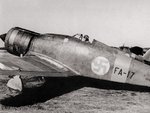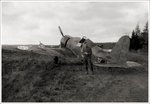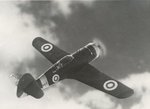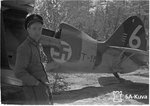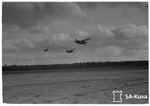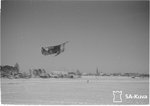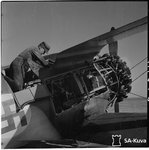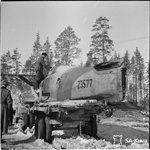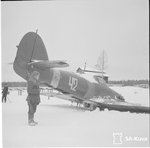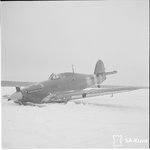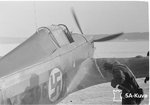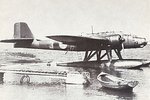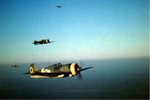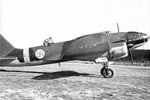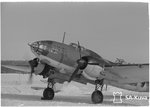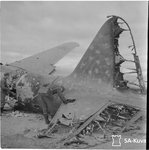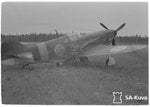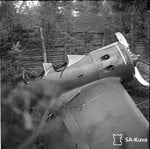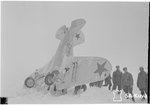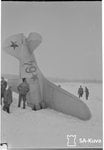- Thread starter
- #21
Attacking Soviet Air Force pilots using formulaic defensive tactics, many Finnish pilots racked up enormous scores on the Finnish front. The default tactic was the four-plane "parvi" (swarm) with a pair flying low (but visible, not too close to the terrain) as the bait and a pair flying high to dive on the eventual interceptors. In the long run, the Soviet Air Force on the Finnish front never developed an efficient approach to counter this tactic. According to some reports, this tactic also inspired the German Luftwaffe's kette.[citation needed] Most of the pilots of Lentolaivue 24 were Winter War combat veterans. This squadron achieved total of 459 Soviet aircraft kills with B-239s, while losing 15 Buffalos in combat. While the remarkable Finnish accomplishments in the Buffalo are undeniable, aviation historian Dan Ford points out that Stalin's purges and recent expansion of the Soviet Air Force resulted in many new inexperienced pilots while simultaneously discouraging combat initiative. The result was pilots who failed to scan the airspace behind them, and also Soviet air formations that held their positions in defensive circles while the diving Finnish pilots picked them off one-by-one. The Soviet fighter aircraft used in the early years on the Finnish front also included some obsolescent models such as the Polikarpov I-15 and I-153. After the end of hostilities, Karhunen, the captain and commander of the 3rd flight of LeLv 24, recalled:
"The Brewster model 239 was good against the older Russian fighters, Polikarpov I-153 Chaika (Gull) and I-16. Hence the period 1941–42 was the best time for us. In 1943 it was already significantly more difficult when the Russians began to use their newer fighters against us... Later, with the Yaks, Hurricanes, Tomahawks, LaGG-3 and MiGs, it became a fight to the death."
The top-scoring Buffalo pilot was Hans Wind, with 39 kills in B-239s. Wind scored 26 of his kills while flying aircraft BW-393, while Eino Luukkanen scored seven more in the same aircraft. After evaluation of claims against Soviet actual losses, aircraft No. BW-364 was credited with 42½ kills in total by all pilots operating it, possibly making it the highest-scoring fighter airframe in the history of air warfare. The top scoring Finnish ace, Ilmari Juutilainen, scored 34 of his 94½ kills in B-239s, including 28 in BW-364. Capt. Jorma Karhunen was another of the top-scoring Buffalo pilots. By 4 May 1943 he had achieved 25½ aerial victories in the Buffalo B-239 fighter, out of his 31½ total kills. One of his major missions took place on 17 December 1941, when two sections of Brewsters encountered nine Soviet Hurricanes and I-153s in reconnaissance over Maaselkä isthmus. The Hawker fighters were from 152ndIAP. The Finns shot down five aircraft, two of which fell to Karhunen in BW-366. On 18 August 1942 he was involved in one of the most successful sorties involving the Buffalo fighter. Lt Hans Wind with six other Buffalos of LeLv 24 intercepted some 60 Soviet aircraft near Kronstad. Two Russian Pe-2 bombers, one Soviet Hurricane fighter, and 12 I-16s were shot down with the loss of just one Buffalo B-239 (BW-378).
During the Continuation War, Finnish designers devised a new aircraft, the Humu, based on the Brewster Buffalo, which was to be produced in Finland from cheaper materials such as plywood, instead of costly aluuminum alloys. Only a single prototype was ever built, since it had become clear that this fighter was already obsolete in 1943. By late 1943, the lack of spare parts, aircraft wear-and-tear, and the improvement of Soviet fighters greatly reduced the effectiveness of the Finnish Buffalo. LeLv 26 pilots still scored some 35 victories against Soviet aircraft in mid-1944. The last aerial victory by a Buffalo against the Soviet Union was scored over the Karelian Isthmus on 17 June 1944. After Finland made a separate peace with the Soviet Union, they were forced to drive out the former ally, Nazi Germany from the country. During the so-called "Lapland War," the only clash with the Luftwaffe took place on 3 October 1944 when HLeLV 26 intercepted a formation of Junkers Ju 87s, heading for a Finnish convoy in the Bay of Bothnia. A Buffalo pilot, Lt. Erik Teromaa (with 11 kills), claimed a Ju 87, and SSgt Oiva Hietala was credited with the second Stuka to fall to the unit. These two victories were the last to be made by Brewster pilots in World War II. Only eight Buffalo B-239s were left at the end of that war in Lapland. Before Finland had swapped sides in the war, its air force had received some Messerschmitt Bf 109s from Germany, and this much-superior fighter aircraft was subsequently used to equip most of the Finnish Air Force fighter squadrons. The five remaining Brewster Buffalos flew until the autumn of 1948, when they were returned to storage. The last flights of the type by the Finnish Air Force were performed on 14 September 1948 by BW-377 and BW-382. They were all scrapped in 1953.
"The Brewster model 239 was good against the older Russian fighters, Polikarpov I-153 Chaika (Gull) and I-16. Hence the period 1941–42 was the best time for us. In 1943 it was already significantly more difficult when the Russians began to use their newer fighters against us... Later, with the Yaks, Hurricanes, Tomahawks, LaGG-3 and MiGs, it became a fight to the death."
The top-scoring Buffalo pilot was Hans Wind, with 39 kills in B-239s. Wind scored 26 of his kills while flying aircraft BW-393, while Eino Luukkanen scored seven more in the same aircraft. After evaluation of claims against Soviet actual losses, aircraft No. BW-364 was credited with 42½ kills in total by all pilots operating it, possibly making it the highest-scoring fighter airframe in the history of air warfare. The top scoring Finnish ace, Ilmari Juutilainen, scored 34 of his 94½ kills in B-239s, including 28 in BW-364. Capt. Jorma Karhunen was another of the top-scoring Buffalo pilots. By 4 May 1943 he had achieved 25½ aerial victories in the Buffalo B-239 fighter, out of his 31½ total kills. One of his major missions took place on 17 December 1941, when two sections of Brewsters encountered nine Soviet Hurricanes and I-153s in reconnaissance over Maaselkä isthmus. The Hawker fighters were from 152ndIAP. The Finns shot down five aircraft, two of which fell to Karhunen in BW-366. On 18 August 1942 he was involved in one of the most successful sorties involving the Buffalo fighter. Lt Hans Wind with six other Buffalos of LeLv 24 intercepted some 60 Soviet aircraft near Kronstad. Two Russian Pe-2 bombers, one Soviet Hurricane fighter, and 12 I-16s were shot down with the loss of just one Buffalo B-239 (BW-378).
During the Continuation War, Finnish designers devised a new aircraft, the Humu, based on the Brewster Buffalo, which was to be produced in Finland from cheaper materials such as plywood, instead of costly aluuminum alloys. Only a single prototype was ever built, since it had become clear that this fighter was already obsolete in 1943. By late 1943, the lack of spare parts, aircraft wear-and-tear, and the improvement of Soviet fighters greatly reduced the effectiveness of the Finnish Buffalo. LeLv 26 pilots still scored some 35 victories against Soviet aircraft in mid-1944. The last aerial victory by a Buffalo against the Soviet Union was scored over the Karelian Isthmus on 17 June 1944. After Finland made a separate peace with the Soviet Union, they were forced to drive out the former ally, Nazi Germany from the country. During the so-called "Lapland War," the only clash with the Luftwaffe took place on 3 October 1944 when HLeLV 26 intercepted a formation of Junkers Ju 87s, heading for a Finnish convoy in the Bay of Bothnia. A Buffalo pilot, Lt. Erik Teromaa (with 11 kills), claimed a Ju 87, and SSgt Oiva Hietala was credited with the second Stuka to fall to the unit. These two victories were the last to be made by Brewster pilots in World War II. Only eight Buffalo B-239s were left at the end of that war in Lapland. Before Finland had swapped sides in the war, its air force had received some Messerschmitt Bf 109s from Germany, and this much-superior fighter aircraft was subsequently used to equip most of the Finnish Air Force fighter squadrons. The five remaining Brewster Buffalos flew until the autumn of 1948, when they were returned to storage. The last flights of the type by the Finnish Air Force were performed on 14 September 1948 by BW-377 and BW-382. They were all scrapped in 1953.


